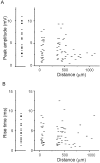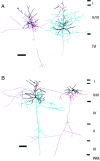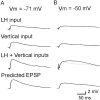Properties of horizontal and vertical inputs to pyramidal cells in the superficial layers of the cat visual cortex
- PMID: 10684894
- PMCID: PMC6772908
- DOI: 10.1523/JNEUROSCI.20-05-01931.2000
Properties of horizontal and vertical inputs to pyramidal cells in the superficial layers of the cat visual cortex
Abstract
The purpose of this study is to elucidate the integrative input mechanisms of pyramidal cells receiving horizontally projecting axon collaterals (horizontal projection) and vertical input from layer IV. We performed whole-cell recordings from pyramidal cells in layer II/III and focally activated other single pyramidal cells monosynaptically connected via long-distance horizontal (LH) projections (the distance between presynaptic and postsynaptic cells was 350-1200 micrometer) in slice preparations of the kitten primary visual cortex. In addition, presynaptic single fibers in layer IV (vertical input) and/or short-distance horizontal (SH) inputs from neighboring single pyramidal cells (distance within 100 micrometer) in layer II/III were activated. Unitary EPSPs evoked by the activation of LH and SH connections had smaller amplitude and larger coefficient of variation than those evoked by stimulating the vertical input. Paired-pulse stimulation of the LH and SH inputs caused the depression of the second EPSP, whereas that of vertical inputs caused either facilitation or depression of the second EPSP. The EPSPs evoked by simultaneous activation of LH and vertical inputs summated linearly at the resting membrane potential. However, the EPSPs evoked by stimulation of the two inputs were nonlinearly (supralinearly) summated when the postsynaptic membrane was depolarized to a certain level. Similar EPSP interaction was observed in response to simultaneous activation of the LH and SH inputs.
Figures










References
-
- Abbott LF, Varela JA, Sen K, Nelson SB. Synaptic depression and cortical gain control. Science. 1997;275:220–224. - PubMed
-
- Akasaki T, Yoshimura Y, Sato H. Modulation of visual response properties by stimulus outside of the classical receptive field in cat area 17. Neurosci Res. 1998;22:S180.344.
-
- Blakemore C, Tobin EA. Lateral inhibition between orientation detectors in the cat's visual cortex. Exp Brain Res. 1972;15:439–440. - PubMed
Publication types
MeSH terms
LinkOut - more resources
Full Text Sources
Miscellaneous
